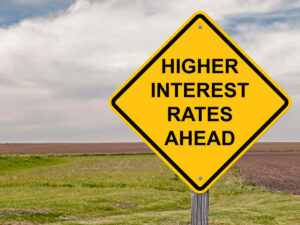Here’s what the latest rate hike—and all the coming hikes—will mean for you.
Due to the rapid interest rate increase seen in the previous year, Federal Reserve officials are adopting a new strategy for 2023. They are opting for a slower and more cautious approach when it comes to rising interest rates. In each meeting held this year, U.S. central bankers have implemented the conventional approach of gradually raising interest rates by a quarter of a percentage point. As a result, the Fed’s benchmark rate currently stands at 5-5.25%, the highest level observed in almost 16 years.
So, what is a rate hike and what does it mean for you?
What is a rate hike?

The idea that the Federal Reserve—or “the Fed” for short—raises interest rates is a bit misleading. The Federal Reserve, which is the central bank in the United States, doesn’t set the interest rate on your credit cards or even your mortgage. In fact, they don’t set consumer rates at all.
Instead, the Fed sets one specific interest rate known as the Federal Funds Rate. That’s the rates that banks use when they borrow and lend to each other. When the Fed raises this rate, banks and lenders raise their rates, too.
Changing the Federal Funds Rate is one of the key tools that the Fed uses to help the economy. When the economy is weak like it was during the pandemic, they slash rates to encourage people to borrow. It stimulates the economy.
By contrast, the Fed hikes interest rates to combat inflation. When prices are skyrocketing, higher interest rates can cool off the economy by decreasing demand. With higher rates, people and businesses don’t borrow as much, tighten their belts, and decrease spending. Effectively, less people are buying and borrowing, so there’s less demand and prices go down.
The best example is our housing market. Home affordability is a serious issue right now. Home prices have increased at an unprecedented pace since 2021. It’s edging many homebuyers out of the market because they simply can’t afford to buy a home.
However, since the Federal Reverse raised rates on March 16, there have been signs that the housing market is starting to cool. Sellers in at least some regions have cut their asking prices because they just can’t find buyers.
So, while rising interest rates may seem like a bad thing, they actually have a positive effect for everyday people. Hopefully, the rising prices we’ve all dealt with since the start of the year will simmer down.
What is the Federal Funds Rate now?
The most recent rate hike of 0.5% means that the current Federal Funds Rate sits at 0.75-1%. The Federal Funds Rate is always expressed as a range. When the Fed raises rates, both the top end rate and the bottom increase by the same percentage.
How does the rate hike impact consumer debt?
Anytime the Fed raises their rate, it can impact some of your existing debts, as well as any new debts. Below, we’ll explain how these rate hikes will affect everyone, as well as how they affect people enrolled in Consolidated Credit’s debt management program.
Rate hike impact on new loans
Any new loans you take out now will have a higher rate than what you could have qualified for before the rate hike. Keep in mind that the Fed says that they will continue raising interest rates to combat inflation. So, if you’re planning on taking out a new loan, you should consider getting organized, so you can apply soon. The longer you wait, the more likely you are to face even higher rates.
The good news for debt management program clients is that you don’t have to wait for the end of your program to get secured loans. If you want to buy a home or a car, you can do that while you’re still enrolled in the program. The only credit you can’t apply for is unsecured – personal loans and credit cards.
If you’re thinking of buying a home, we encourage you to talk to one of our HUD-certified housing counselors. They can help you make a customized action plan that can get you through the home buying process as quickly as possible.
Call 1-800-435-2261 to speak with a housing counselor for free.
Rate hike impact on existing loans
If you have existing loans, the rate hike will only affect them if you have variable interest rates. For any fixed-rate loans, the interest rate is locked in, meaning it won’t change unless you refinance. However, the rates on any adjustable-rate loans may increase the next time your loans adjust. Some adjustable-rate loans adjust periodically, such as every month or year. Other adjustable-rate loans known as hybrid loans only adjust once.
For example, if you have a hybrid 5/1 mortgage, that means that the interest rate will adjust once after five years. If your rate adjustment is coming up, then expect the interest rate on the loan to increase.
Bear in mind that even a small increase in the rate on a large loan like a mortgage will have a big impact. Even just a small increase could equal out to tens of thousands of dollars extra paid over the life of your mortgage. So, if you have an adjustable-rate loan, you may want to talk to your lender to see if you can refinance. If you can lock in a fixed-rate loan now, it will help you save money.
Rate hike impact on credit cards
Almost all credit cards have adjustable rates – fixed-rate credit cards exist, but they are extremely rare. So, credit users should expect their interest rates to increase at least some time in the next year.
How the Rate Hike Impacts People with Credit Card Debt
If you’re carrying balances on your credit cards, then this latest rate hike can affect both the rates applied to those balances as well as your ability to pay them off quickly. This video explains why this rate hike could make it harder to pay off your debt and where to turn for a solution.
What do rate hikes mean for you?
It means your credit card balances are about to get more expensive.
And that consolidating them on your own with a loan is going to be challenging.
They may not offer the low rate your need.
Luckily, the folks at Consolidated Credit are here to help.
You could consolidate you bills into one affordable payment, while they work with creditors to reduce or even eliminate interest.
You could save thousand and save your credit.
Keep in mind that credit card companies must give you 45 days-notice before they raise your interest rate. Be on the lookout for notices from your creditors in case this happens. It’s a good idea to take steps to pay off any balances you have so you won’t need to worry if rates increase.
Need a solution to get ahead of rate hikes? We can help.
For debt management program clients, these rate hikes will have less of an impact. The credit counseling team worked with creditors to reduce or even eliminate the rates on any credit cards included in the program. The rate hike won’t impact those rates. For example, if your creditor agreed to drop your rate to 2%, it will stay at 2% as long as you remain in the program. The only way that a rate hike will impact a credit card included in the program is if you drop out. Then, the creditor may restore your original rates with any new rate hikes factored in.
The only credit card APR you need to be concerned about is on any card that you left out of the program. If you kept a credit card out for emergencies, then watch your monthly credit card statements. The creditor may notify you soon of an increase in your APR. If they do, make sure to keep that card paid off so interest charges don’t get applied every month. If you already have a balance, we recommend that you call client services at (844) 276-1544 to add the card to your program.
Rate hikes are great for savers

Rate hikes aren’t good for borrowers because they mean higher interest charges. On the flipside, rate hikes are extremely good for savers. Not only do changes to the Federal Funds Rate affect consumer debt, they also affect consumer savings, too. Savings tools have APY, which is an interest rate that works in your favor. It determines how much money you make on an account and how quickly your money grows. Just like higher APR means your debt costs more, higher APY means that you earn more.
So, higher interest rates are good news for savers. This is good news for debt management program clients, too. Since you’re in the process of paying off your debt, you can start focusing on saving. First, check the interest rate earned on your current savings account. The national average is only around 0.2%.
However, with each rate hike, you will start to find savings accounts with better growth. The last time the Fed hiked up rates, you could find basic savings accounts with rates as high as 2.25%.
If you save $1,000 at 0.2% then you only earn $2 after one year. If you save the same $1,000 at 2.25%, then you earn $22.50 in one year.
Once you know what the rate on your savings account is, you can start researching other accounts. Start with shopping around through your own bank or credit unions, you can also compare accounts online through sites like Bankrate.
It’s worth noting that savings accounts that offer faster growth with higher rates may have account requirements. For instance, you may be required to maintain a minimum balance of $1,000. So, you want to make sure you’re financially stable before getting one of these accounts. For those already getting credit card debt under control, it should be easier to maintain financial stability. As a result, you can take advantage of better savings tools because you’ll have the funds and the budget stability to use them effectively.